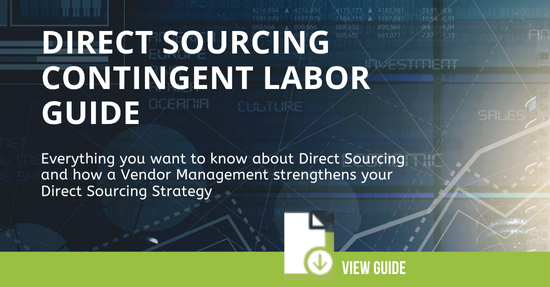To ensure the success of your contingent workforce program, swiftly filling positions with top-notch contingent workers enhances your business's competitiveness and agility. Consequently, more organizations are adopting direct sourcing programs to supplement their current contingent workforce hiring strategies.
In this article, we explore the technologies available for managing your direct sourcing program and explain why we advise integrating it within your vendor management system alongside your overall contingent workforce management program.
What is Direct Sourcing?
Direct sourcing differs from the traditional method of hiring contingent workers, where organizations use staffing agencies to fulfill their requirements. Direct sourcing, instead, focuses on building a pool of freelancers, consultants and temporary workers that can be hired internally instead of through a vendor. It’s like becoming your own staffing agency.
When companies augment their existing contingent workforce hiring program with a direct sourcing strategy, they can access benefits such as:
- faster hiring cycles
- cost savings (when managed correctly)
- strong internal relationships with contingent workers, meaning they can be re-engaged over and over again when required
- more control over the contingent workforce hiring process
- and easier onboarding since directly sourced workers are already familiar with your business
These benefits can only be realized, however, if these workers are managed correctly
This begs the question, should organizations manage their directly sourced workers in the vendor management systems they use to manage their entire contingent workforce program, or should they use a different system to separate their direct sourcing strategy?
What is Direct Sourcing technology?
When implementing a direct sourcing program, one of the first places companies look is towards a standalone piece of technology that’s solely responsible for the management of direct sourcing.
In recent years, there have been an increasing number of technologies designed specifically for direct sourcing. This technology is still relatively new to the industry, but it is created to help companies build centralized internal talent pools of contingent workers and automate the processes around engaging and managing these workers.
This makes it easier for hiring managers to source and manage contingent workers, since they can access talent pools of engaged contingent workers in one centralized system.
The functionality of direct sourcing technology is similar to a freelancer management system (FMS). Some of the top functionalities of direct sourcing technology include:
- The ability to curate contingent workers into talent pools
- The automation of end-to-end direct sourcing processes
- The ability to consistently communicate with your talent pools, so you can keep candidates engaged with your brand
- Talent matching capabilities for specific projects and roles
- Direct sourcing reporting and analytic capabilities so you can measure the performance of your program
Direct sourcing technology, in some cases, has integrations with vendor management systems.
What is a vendor management system?
A vendor management system is a platform, typically accessed through the cloud, that acts as a centralized system where your organization can manage its entire contingent workforce management program.
By centralizing your contingent workforce management program your organization will gain complete visibility over both your contingent workers, and the staffing agencies you use to source them. This increased visibility gives you actionable insights into how your program is performing and how much your business is spending on its contingent workforce.
Through automation of contingent workforce management processes such as procurement, management, and payment, your business will save significant amounts of time through process efficiencies that allow you to focus on valuable tasks that drive profitability.
Functionality of a vendor management system, includes:
- Process automation, including process requisitions, process approvals, onboarding and much more.
- Reporting and analytics that enable you to improve your contingent workforce management process.
- The centralization of all contingent workforce data - including the standardization of processes and rates.
- The optimization of staffing agency management.
Why you should manage your direct sourcing program within in a VMS
One of the main problems that businesses face when it comes to management of their contingent workforce program is the use of fragmented systems and processes. In fact, most organizations manage their program and save information through manual spreadsheets - or worse, emails.
The result is a complete lack of visibility and control into how much their contingent workforce costs and how their program is performing.
It’s for this reason why we recommend you manage your direct sourcing program within your vendor management system. This will ensure that you keep all of your contingent workforce data in ONE place - giving you complete visibility and control of your entire contingent workforce program.
That’s why if you are thinking about implementing a direct sourcing strategy, then it’s important that you check whether your existing VMS has direct sourcing capabilities - or at the very least is able to integrate with a direct sourcing technology.
Read more at: Why a Vendor Management System is Essential for Direct Sourcing
Learn More about Direct Sourcing
Check out our Direct Sourcing Guide to learn more about Direct Sourcing, its benefits and how a Vendor Management System strengthens a Direct Sourcing Strategy: View Direct Sourcing Guide
Discover the Power of Conexis VMS for Direct Sourcing
Conexis is an award-winning Vendor Management System built for organizations that want the power of enterprise software without the complexity or cost.
Leveraging the latest technology, Conexis delivers the expertise, reliability, and security of enterprise systems, while offering the flexibility, user friendliness and tailored, personal service you require. Learn more about our Company and why organizations Choose Conexis VMS.
Additional Articles on this Topic:






